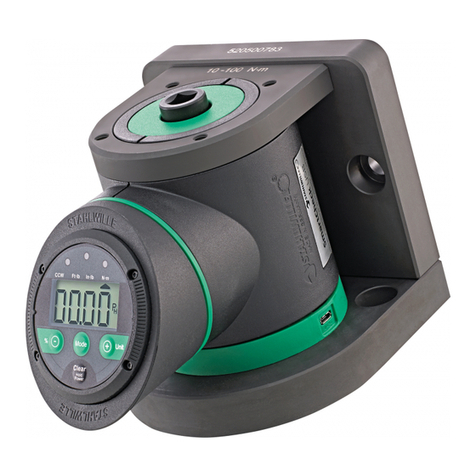Stahlwille perfectControl 7794-2 User manual

English version of original German operating
instructions
EN
STAHLWILLE perfectControl
Motor-operated calibration and adjustment facility 7794-2
Read through these operating instructions carefully to ensure safe operation. Store these
instructions for further use.
Code number 91979873
Status: 06/2016

Preface
2
Preface
These operating instructions help you to make
•proper,
•safe and
•economical
use of the motor-operated calibration and
adjustment facility.
Target group of these operating
instructions
The operating instructions are aimed at the users of
the motor-operated calibration and adjustment
facility.
The information contained in these operating
instructions is aimed at authorised, trained and
familiarised personnel. We assume that these
persons possess general technical knowledge.
Each person who
•transports
•installs,
•dismantles,
•operates,
•maintains or
•disposes of
the adjustment and calibration facility must have
read and understood the corresponding contents of
these operating instructions.
If you do not understand any of the information in
these operating instructions or information is
missing, please contact
STAHLWILLE Eduard Wille GmbH & Co. KG.

Contents
Preface ........................................................................................................................................................ 2
Target group of these operating instructions ...................................................................................................... 2
Introduction to the operating instructions ................................................................................................. 6
Availability ........................................................................................................................................................... 6
Supplements ....................................................................................................................................................... 6
Structural features .............................................................................................................................................. 6
Explanation of the warning notices ..................................................................................................................... 6
Safety .......................................................................................................................................................... 7
Proper use, operating area ................................................................................................................................. 7
Basic safety instructions ..................................................................................................................................... 7
Dangers due to electrical energy .............................................................................................................. 7
Risk of injury due to damaged calibration objects .................................................................................... 7
Risk of injury due to crushing ................................................................................................................... 8
Hazards due to noise ............................................................................................................................... 8
Environmental pollution due to incorrect disposal .................................................................................... 8
Avoiding material damage .................................................................................................................................. 8
Warranty and liability .......................................................................................................................................... 8
Changes to the design of the calibration and adjustment facility ....................................................................... 8
Duties when handling this calibration and adjustment facility ............................................................................ 9
Obligations on the part of the owner ........................................................................................................ 9
Obligations on the part of the personnel .................................................................................................. 9
Personnel training ............................................................................................................................................... 9
Safety equipment ................................................................................................................................................ 9
Safety measures during normal operation.......................................................................................................... 9
Protective facilities ............................................................................................................................................ 10
Emergency stop button .......................................................................................................................... 10
Protective cover ...................................................................................................................................... 10
Edge guard on the longitudinally adjustable carriage ............................................................................ 10
Limitation of the movement range .......................................................................................................... 11
Motor overload protection ....................................................................................................................... 11
Transducer overload............................................................................................................................... 11
Calibration object overload ..................................................................................................................... 11
Warning and instruction signs .......................................................................................................................... 11
Technical description ............................................................................................................................... 12
Overview ........................................................................................................................................................... 12
Technical data .................................................................................................................................................. 13
Electrical protection .......................................................................................................................................... 14
Identification ...................................................................................................................................................... 14
Transportation, delivery, storage ............................................................................................................. 14

Transportation ................................................................................................................................................... 14
Unpacking ......................................................................................................................................................... 15
Delivery ............................................................................................................................................................. 16
Scope of delivery .................................................................................................................................... 16
Check on acceptance by the recipient ................................................................................................... 16
Reporting and documenting transport damage ...................................................................................... 16
Packaging ............................................................................................................................................... 17
Storage ............................................................................................................................................................. 17
Erection and mounting ............................................................................................................................. 18
Installing extension 7791-1 ....................................................................................................................... 18
Connecting ................................................................................................................................................ 21
Characteristic electrical data of the control system .......................................................................................... 21
Overview of external connections ..................................................................................................................... 21
Establishing connections .................................................................................................................................. 22
Operating the calibration and adjustment facility ................................................................................... 23
Controls............................................................................................................................................................. 23
Control functions ............................................................................................................................................... 24
Using the TORKMASTER 4 programme ................................................................................................... 25
Installing the software ....................................................................................................................................... 25
Installing the TORKMASTER 4 programme ........................................................................................... 25
Manually installing the driver .................................................................................................................. 27
The main menu controls ................................................................................................................................... 28
Operating the TORKMASTER 4 programme ................................................................................................... 31
Preparing for operation ............................................................................................................................ 32
Preparing the calibration and adjustment facility .............................................................................................. 32
Preparing the PC .............................................................................................................................................. 32
Calibrating and adjusting torque wrenches ............................................................................................ 33
Starting the calibration and adjustment facility ................................................................................................. 33
Set-up mode ..................................................................................................................................................... 33
Testing and adjusting ........................................................................................................................................ 34
Clicking calibration ............................................................................................................................................ 34
Measuring calibration ........................................................................................................................................ 35
Maintenance .............................................................................................................................................. 36
Cleaning ............................................................................................................................................................ 36
Exchanging fuses ............................................................................................................................................. 36
Lubricating ........................................................................................................................................................ 37
Maintenance schedule for the mechanical system ........................................................................................... 38

Disposal .................................................................................................................................................... 39
Information on extension lengths ............................................................................................................ 39
The correct tightening torque with unchanged extension lengths .................................................................... 39
The correct tightening torque with changed extension lengths ........................................................................ 39
Example 1: corrected setting value (one plug-in tool) ............................................................................ 40
Example 2: corrected setting value (plug-in tool and adapter) ............................................................... 41
General information on calibration .......................................................................................................... 42
Torque wrench dimension tables ............................................................................................................. 43
Subsequent additions to the operating instructions ............................................................................... 47
EU declaration of conformity ................................................................................................................... 48
Other manuals for perfectControl 7794-2
1
Table of contents
Other Stahlwille Test Equipment manuals
Popular Test Equipment manuals by other brands

Redtech
Redtech TRAILERteck T05 user manual

Venmar
Venmar AVS Constructo 1.0 HRV user guide

Test Instrument Solutions
Test Instrument Solutions SafetyPAT operating manual

Hanna Instruments
Hanna Instruments HI 38078 instruction manual

Kistler
Kistler 5495C Series instruction manual

Waygate Technologies
Waygate Technologies DM5E Basic quick start guide

StoneL
StoneL DeviceNet CK464002A manual

Seica
Seica RAPID 220 Site preparation guide

Kingfisher
Kingfisher KI7400 Series Training manual

Kurth Electronic
Kurth Electronic CCTS-03 operating manual

SMART
SMART KANAAD SBT XTREME 3G Series user manual

Agilent Technologies
Agilent Technologies BERT Serial Getting started










